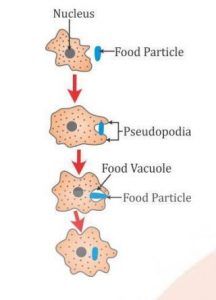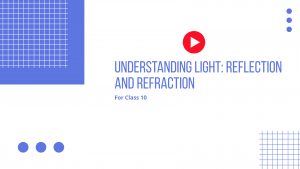NCERT Solutions for Science Class 9 Chapter 5

Chapter 5: The Fundamenta Unit of Life
Question 1: Who discovered cells and how?
Answer: Cells were discovered by Robert Hooke in 1665. He observed the honeycomb-like structure in a cork slice using a basic microscope.
Question 2: Why is cell called the structural and functional unit of life?
Answer: All living organisms are made up of a basic unit called cell. Each living cell has the capacity to perform certain basic functions that are characteristics of all living forms. A cell is able to live and perform all its functions because of these organelles. Each kind of cell organelle performs a special function such as making new material in the cell, clearing up the
waste material from the cell and so on. Because of these reasons, cells are called basic structural and functional unit of life.
Question 3: How do substances like CO2 and water move in and out of the cell? Discuss.
Answer: The substances like carbon dioxide and water move in and out of a cell by diffusion from the region of high concentration to low concentration. When the concentration of carbon dioxide and water is higher outside the cell than inside the cell, CO2 and water move inside the cell. When the concentration outside the cell becomes low and it is high inside the cell, they move out.
Question 4: Why is the plasma membrane called a selectively permeable membrane?
Answer: The cell membrane or the plasma membrane is known as a selectively permeable membrane because it regulates the movement of substances in and out of the cell. This means that the plasma membrane allows the entry of only some substances and prevents the movement of some other materials.
Question 1: Fill in the gaps in the following table illustrating differences between prokaryotic and eukaryotic cells.
| Prokaryotic cell | Eukaryotic cell |
| 1. Size: generally small \((1-10\space^{\mu} m)1\space^{\mu} m=10^{-6}\space m\) | 1. Size: generally large \((5-100\space^{\mu}m)\) |
2. Nuclear region: _________________ and is known as _________. | 2. Nuclear region: well-defined and surrounded by a unclear membrane |
3. Chromosome: single | 3. More than one chromosome |
4. Membrane-bound cell organelles are absent | 4. ________________ |
Anwer:
| Prokaryotic cell | Eukaryotic cell |
| 1. Size: generally small \((1-10\space^{\mu}m=10^{-6}m\) | 1. Size: generally large \((5-100\space^{\mu}m)\) |
| 2. Nuclear region poorly defined because of the absence of a nuclear membrane, and is known as uncleoid. | 2. Nuclear region: well-defined and surrounded by a nuclear membrane |
| 3. Chromosome: single | 3. More than on echromosome |
| 4. Membrane-bound cell organelles are absent | 4. Membrane-bound cekk irganells such as mitochondria, plastids, etc., are present |
Question 1: Can you name the two organelles we have studied that contain their own genetic material?
Answer: Mitochondria and plastids.
Question 2: If the organisation of a cell is destroyed due to some physical or chemical influence, what will happen?
Answer: If any damage happens to the cell due to any influence the cell will not be able to perform any basic functions like respiration, nutrition, etc. This may stop all life activities. This is when lysosome bursts and enzyme digest such cells.
Question 3: Why are lysosomes known as suicide bags?
Answer: Lysosomes are the vesicular structures that contain digestive enzymes. These enzymes in lysosomes are capable of breaking down any foreign body entering the cell. At times,
lysosomes can cause self-destruction of a cell by releasing these digestive enzymes within the cells. This is the reason lysosomes are called suicidal bags.
Question 4: Where are proteins synthesized inside the cell?
Answer: Proteins are synthesised in the ribosomes. These ribosomes are small structures found either suspended in the cytoplasm or attached to the surface of the endoplasmic reticulum.
Question 1: Make a comparison and write down ways in which plant cells are different from animal cells.
Answer:
| Animal cell | Plant cell |
| Animal cells are smaller compared to plant cells. | Plants cells are comparatively larger |
| Cell wall is absent | Cell wall is present |
| Vacuoles are smaller in size and more in bumber | One central large vacuole is present |
| Animal cell | Plant cell |
Question 2: How is prokaryotic cell different from a eukaryotic cell?
Answer:
| Prokaryotic cell | Eukaryotic cell |
| Unicellular | Multicellular |
| Unicellular | Mulricellular |
| Small in size | Comparatively larger |
| Nuclear membrane absent ot the cell lacks a true nucleus. | True nulcleus bound by a nuclear membrane is present in the cell. |
| It contains a single chromosome. | It contains more than one chromosome. |
| The nucleolus is absent. | The nucleolus is present. |
| Cell division occurs only by mitosis. | Cell division occurs by mitosis and meoisis. |
| Prokaryotic cell are found in bacteria and blue-green algae. | Eukaryotice cells are found in fungi, plants and animal cells. |
Question 3: What would happen if the plasma membrane ruptures or breaks down?
Answer: As the plasma membrane regulates the movement of substances in and out of the cell by diffusion or osmosis, if there is any rupture on the plasma membrane then the cell might leak out its contents.
Question 4: What would happen to the life of a cell if there was no Golgi apparatus?
Answer: If there was no Golgi apparatus packaging of the proteins or the structural protein arrangement will not happen inside a cell. If proteins are not transported, metabolism in the
cell will not take place and eventually the cell will die.
Question 5: Which organelle is known as the powerhouse of the cell? Why?
Answer: Mitochondria are known as the powerhouse of cells. The energy required for various chemical activities needed for life is released by mitochondria in the form of ATP molecules.
The body uses energy stored in ATP for making new chemical compounds and for mechanical work. For this reason, mitochondria are known as the powerhouse of cells.
Question 6: Where do the lipids and proteins constituting the cell membrane get synthesized?
Answer: Lipids are synthesised in smooth endoplasmic reticulum whereas proteins are synthesised in Rough endoplasmic reticulum
Question 7: How does an Amoeba obtain its food?
Answwer: Amoeba acquires its food through a process called endocytosis. Amoeba has a flexible plasma membrane which enables the cell to engulf the food particles and other materials from its external environment.

Question 8: What is osmosis?
Answer: Osmosis is the movement of water molecules from a region of high-water concentration to low water concentration through a selectively permeable membrane till equilibrium is reached.
Question 9: Carry out the following osmosis experiment:
Take four peeled potato halves and scoop each one out to make potato cups. One of these potato cups should be made from a boiled potato. Put each potato cup in a trough containing
water. Now,
(a) Keep cup A empty
(b) Put one teaspoon sugar in cup B
(c) Put one teaspoon salt in cup C
(d) Put one teaspoon sugar in the boiled potato cup D.
Keep these for two hours. Then observe the four potato cups and Solution the following:
(i) Explain why water gathers in the hollowed portion of B and C.
(ii) Why is potato A necessary for this experiment?
(iii) Explain why water does not gather in the hollowed-out portions of A and D.
Answer:
(i) Water gathers in the hollowed portions of set-up B and C because the concentration of the water surrounding to the potato is higher comparatively, through osmosis, water enters the
potato.
(ii) Potato A in the experiment acts as a control set-up to compare the changes in the other two setups.
(iii) In cup A there is no change in the concentration. In cup D, plasmolysis has taken place because of the boiling due to which osmosis will not take place.
Study materials
- Refernce Books
- NCERT Solutions
- Syllabus







